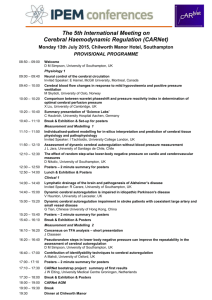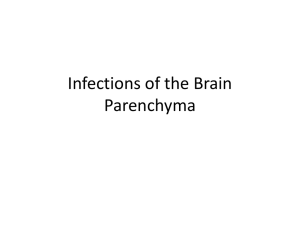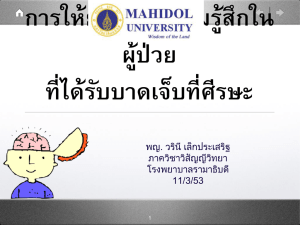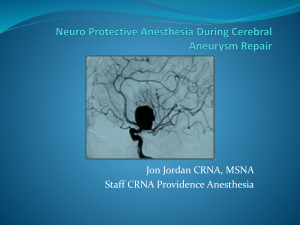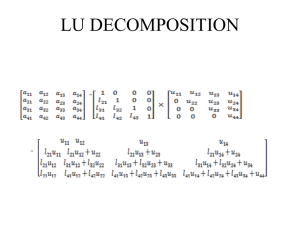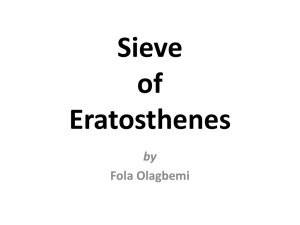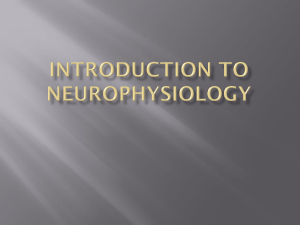TS1 - Cerebral AutoRegulation Network
advertisement
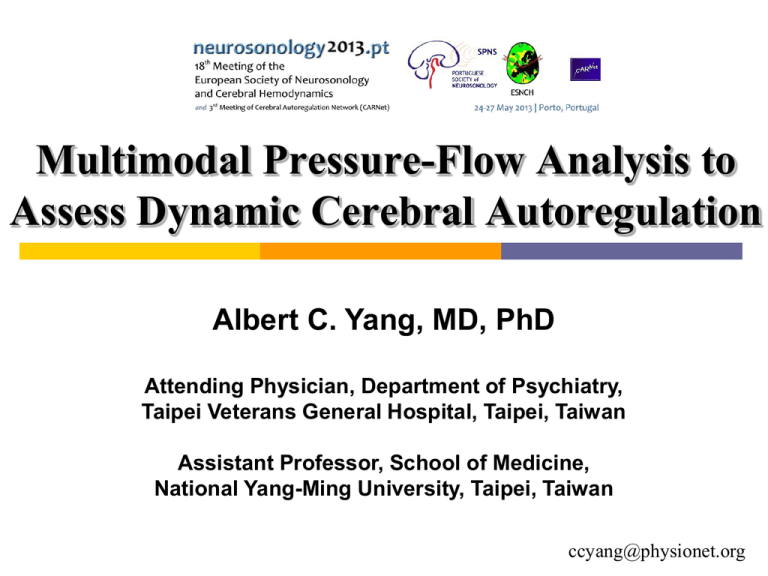
Multimodal Pressure-Flow Analysis to Assess Dynamic Cerebral Autoregulation Albert C. Yang, MD, PhD Attending Physician, Department of Psychiatry, Taipei Veterans General Hospital, Taipei, Taiwan Assistant Professor, School of Medicine, National Yang-Ming University, Taipei, Taiwan ccyang@physionet.org Overview What is cerebral autoregulation and how to measure it? Multimodal pressure-flow analysis Empirical Mode Decomposition and Hilbert-Huang Transform Subsequent improvement Demonstration Body as Servo-Mechansim Type Machine • Importance of corrective mechanisms to keep variables “in bounds.” • Healthy systems are self-regulated to reduce variability and maintain physiologic constancy. Perturbation Baseline Restored steady state Underlying notion of “constant,” “steady-state,” conditions. Walter Cannon 1929 Ideal Cerebral Autoregulation Lassen NA. Physiol Rev. 1959;39:183-238 Strandgaard S, Paulson OB. Stroke.1984;15:413-416 Static Autoregulation Measurement Tiecks FP et al., Stroke. 1995; 26: 1014-1019 Dynamic Autoregulation Measurement Tiecks FP et al., Stroke. 1995; 26: 1014-1019 Autoregulation Index Tiecks FP et al., Stroke. 1995; 26: 1014-1019 Challenges of Cerebral Autoregulation Assessment • Blood pressure and cerebral blood flow velocity are often nonstationary and their interactions are nonlinear. • Need a new method that can analyze nonlinear and nonstationary signals. Novak V et al., Biomed Eng Online. 2004;3(1):39 Multimodal Pressure-Flow Analysis Participants 15 normotensive healthy subjects 20 hypertensive subjects age 40.2 ± 2.0 years age 49.9 ± 2.0 years 15 minor stroke subjects 18.3 ± 4.5 months after acute onset age 53.1 ± 1.6 years Novak V et al., Biomed Eng Online. 2004;3(1):39 Measurements Blood pressure Finger Photoplethysmographic Volume Clamp Method. Blood flow velocities (BFV) from bilateral middle cerebral arteries (MCA) Transcranial Doppler Ultrasound. Novak V et al., Biomed Eng Online. 2004;3(1):39 Valsalva Maneuver Arterial Blood Pressure HHT residual 180 I. Expiration - 160 mechanical IV I mmHg 140 IV. increased cardiac output and increased peripheral resistance 120 100 80 III 60 II. reduced venous return, BP falls 40 20 30 40 III. Inspiration - mechanical II 50 Time (sec) 60 70 80 Valsalva Maneuver Dynamics Blood Pressure Blood Flow Velocity – Right Middle Cerebral Artery Blood Flow Velocity – Left Middle Cerebral Artery Empirical Mode Decomposition (EMD) 黃 鍔 院士 Norden E. Huang The Empirical Mode Decomposition Method and the Hilbert Spectrum for Non-stationary Time Series Analysis, (1998) Proc. Roy. Soc. London, A454, 903-995. The motivation of EMD development was to solve the problems of non-linearity and non-stationarity of the data Is an adaptive-based method Cited 7,722 Times! Empirical Mode Decomposition Huang et al. Proc Roy Soc Lond A 1998;454:903-995. Empirical Mode Decomposition Step 1: Find the envelope alone local maximum and minimum Huang et al. Proc Roy Soc Lond A 1998;454:903-995. Empirical Mode Decomposition Step 2: Find the average between envelopes Huang et al. Proc Roy Soc Lond A 1998;454:903-995. Empirical Mode Decomposition Intrinsic Mode Function Step 3: To determine the fluctuation of original signal around the average of envelopes Huang et al. Proc Roy Soc Lond A 1998;454:903-995. Empirical Mode Decomposition Sifting : to get all IMF components x( t ) c1 r1 , r1 c2 r2 , . . . rn 1 cn rn . x( t ) n c j 1 j rn . Huang et al. Proc Roy Soc Lond A 1998;454:903-995. Original Data Empirical Mode Decomposition A Simple Example 2 0 -2 0 10 20 30 40 50 60 0 10 20 30 40 50 60 0 10 20 30 40 50 60 0 10 20 30 40 50 60 IMF 1 1 0 -1 IMF 2 1 0 IMF 3 -1 0.5 0 -0.5 Empirical Mode Decomposition Original blood pressure waveform Key mode of blood pressure waveform during Valsalva maneuver Blood Pressure versus Blood Flow Velocity Temporal (time) Relationship Novak V et al., Biomed Eng Online. 2004;3(1):39 Blood Pressure versus Blood Flow Velocity Phase Relationship Control Stroke Novak V et al., Biomed Eng Online. 2004;3(1):39 Between Groups Phase Comparisons *** p < 0.005, ** p < 0.01 Groups BPR Values Comparisons +++ p <0.001 Conventional Autoregulation Indices Novak V et al., Biomed Eng Online. 2004;3(1):39 Summary: Original Version of MMPF Analysis Regulation of BP-BFV dynamics is altered in both hemispheres in hypertension and stroke, rendering BFV dependent on BP. The MMPF method provides high time and frequency resolution. This method may be useful as a measure of cerebral autoregulation for short and nonstationary time series. Limitations: Original Version of MMPF Analysis Requires visual identification of key mode of physiologic time series Mode mixing with original EMD analysis Valsalva maneuver itself has certain risk Subsequent Improvements of MMPF Analysis Use Ensemble EMD (EEMD) Analysis Wu, Z., et al. (2007) Proc. Natl. Acad. Sci. USA., 104, 14889-14894 Resting-state MMPF Analysis K. Hu, et al., (2008) Cardiovascular Engineering Selection of key mode related to respiration during resting-state condition M-T Lo, k Hu et al., (2008) EURASIP Journal on Advances in Signal Processing Comparison of phase shifts in multiple time scales Hu K et al., (2012) PLoS Comput Biol 8(7): e1002601 Implementation and automation of the method Dr. Yanhui Liu. DynaDx Corp. U.S.A. Resting-State Multimodal Pressure-Flow Analysis K. Hu, et al., Cardiovascular Engineering, 2008. Respiratory Signals From Blood Pressure Time Series M-T Lo, k Hu et al., EURASIP Journal on Advances in Signal Processing, 2008 Resting-State Multimodal Pressure-Flow Analysis Resting-State Multimodal Pressure-Flow Analysis Cerebral Blood Flow Regulation at Multiple Time Scales Hu K et al., PLoS Comput Biol 2012; 8(7): e1002601 Traumatic Brain Injury and Cerebral Autoregulation k. Hu, M-T Lo et al., journal of neurotrauma, 2009 Traumatic Brain Injury and Cerebral Autoregulation k. Hu, M-T Lo et al., journal of neurotrauma, 2009 Midline Shift Correlates to LeftRight Difference in Autoregulation k. Hu, M-T Lo et al., journal of neurotrauma, 2009 Resources Empirical Mode Decomposition (Matlab) http://rcada.ncu.edu.tw/research1.htm DataDemon (Generic Analysis Platform) For 64-bit system, https://dl.dropbox.com/u/7955307/daily_build/x64/Data DemonSetupPRO.msi For 32-bit system, https://dl.dropbox.com/u/7955307/daily_build/x86/Data DemonSetupPRO.msi Acknowledgements Vera Novak, MD, PhD Yanhui Liu, PhD Chung-Kang Peng, PhD Kun Hu, PhD Albert C. Yang, MD, PhD Ment-Zung Lo, PhD

